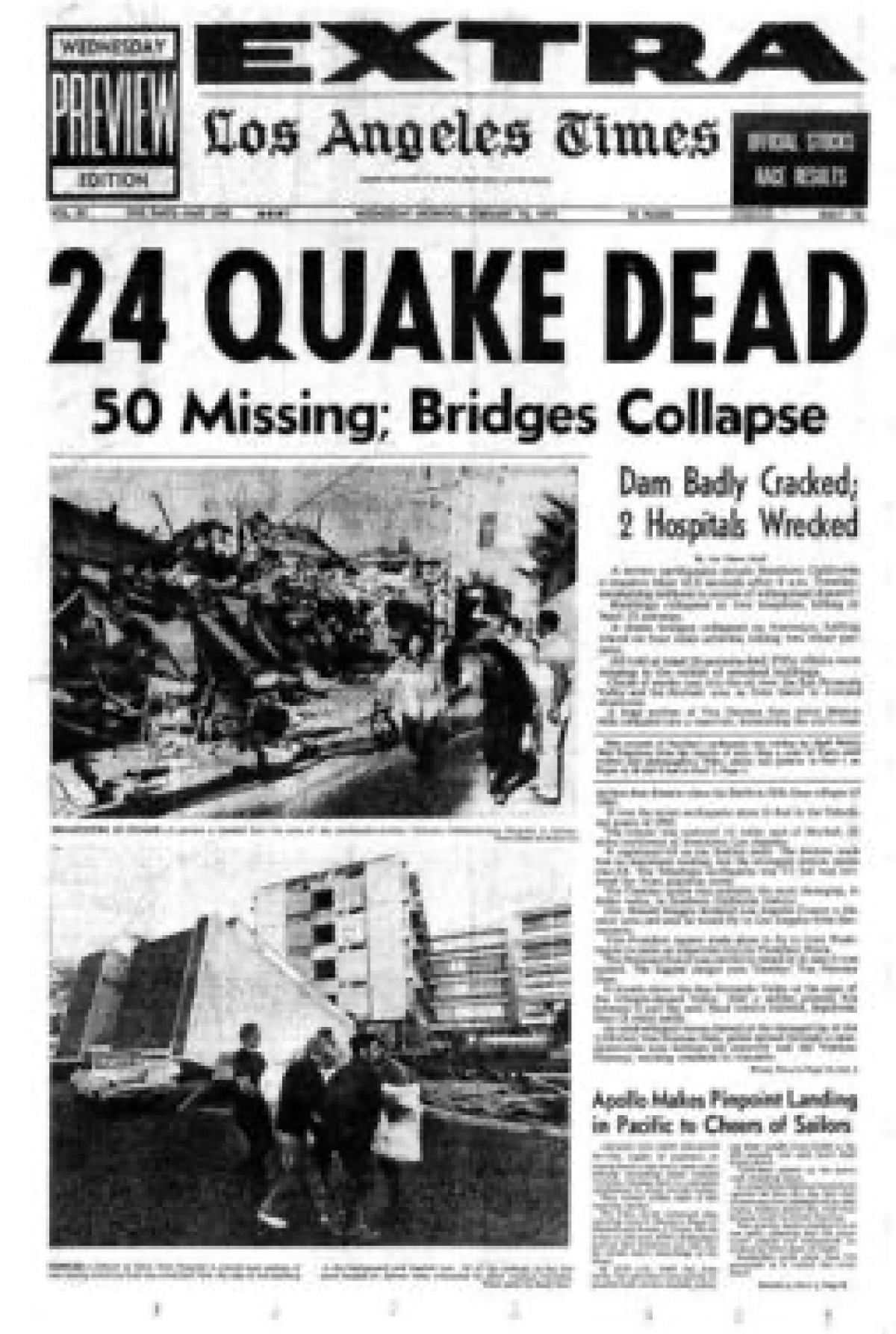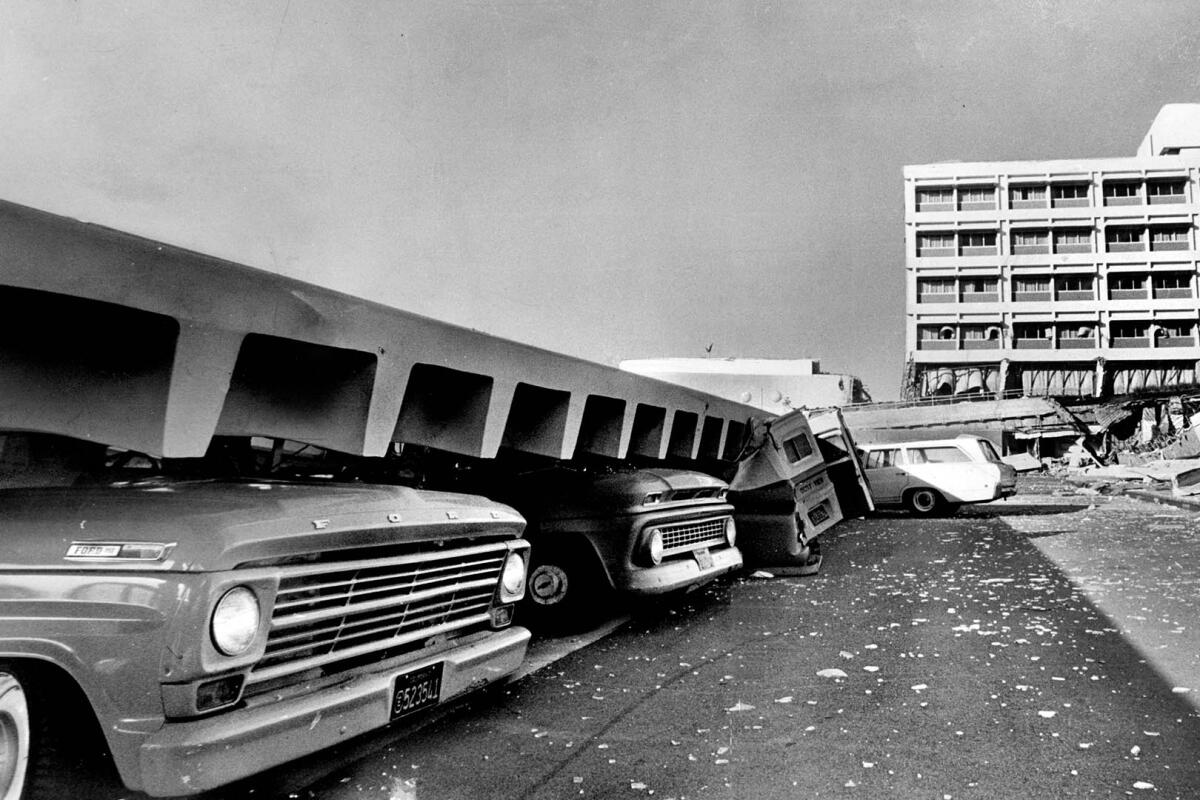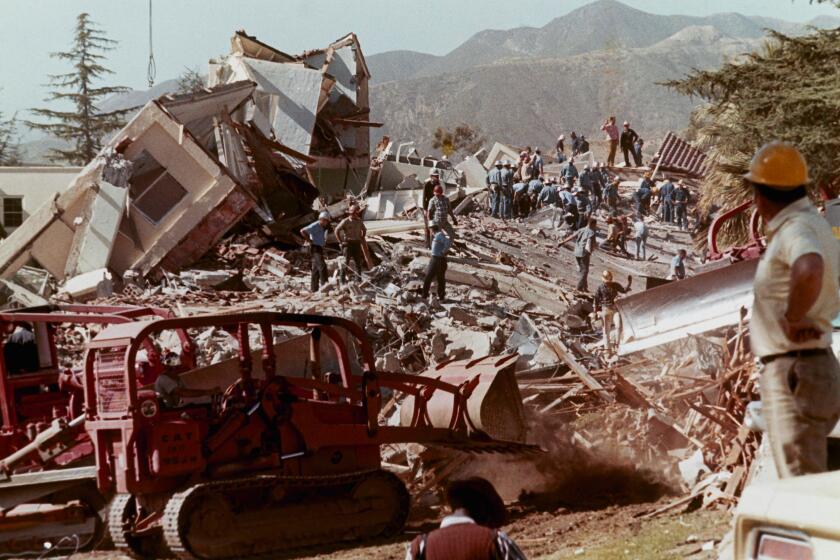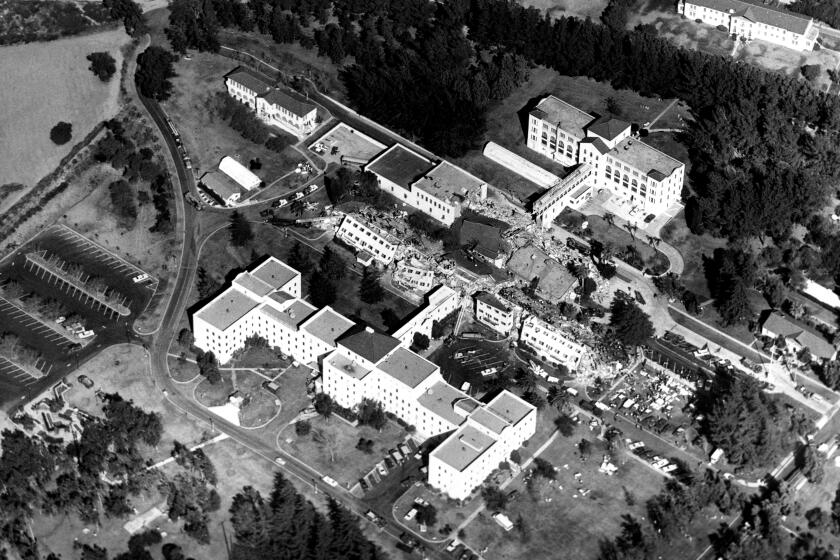50 years ago, the Sylmar earthquake shook L.A., and nothing’s been the same since

The magnitude 6.6 Sylmar earthquake that shook Southern California on Feb. 9, 1971, caused significant damage and 64 deaths. What few realized at the time was how close it came to being far more catastrophic. The disaster still holds lessons 50 years later.
- Share via
How close Los Angeles came to what would have been — many times over— the deadliest disaster in U.S. history remains a matter of historical conjecture.
When the Sylmar earthquake rumbled through Los Angeles 50 years ago, on Feb. 9, 1971, the top of the earthen Lower Van Norman Dam melted into the reservoir. No one knows exactly what kept the dam near Granada Hills from collapsing. Was it the number of feet of earthen wall that remained? Was it the duration of the quake, since a few more seconds might have shaken loose the rest of the dam face, unleashing a torrent on tens of thousands of homes below?
That the dam survived has rendered those questions a subject for scientific inquiry rather than the annals of catastrophe.
But what might have been remains part of the mystique that sustains the Sylmar earthquake — formally, the San Fernando earthquake — as the keystone in the long arc of seismic knowledge and the practice of earthquake safety. The quake might not have been the Big One, but it still managed to wake California up to a danger that was largely unrecognized. The modern era of earthquake awareness and preparedness is deeply rooted in Sylmar.
Before then, earthquakes were either removed in time — 1906 in San Francisco, 1933 in Long Beach — or physically distant —1964 in Anchorage.
The 6.6 magnitude earthquake that struck the northeast San Fernando Valley seconds after 6 a.m. not only woke up the city but fixated the nation’s budding seismic community as none had before.

“Los Angeles was the city of the future,” said geophysicist Susan Hough of the U.S. Geological Survey’s Earthquake Sciences Center. “You had the space-age LAX. You have this modern glistening city and all of a sudden hospitals are being knocked down. It really got people’s attention in many ways.”
The indelible images of Sylmar were the hospitals.
At the Veterans Administration Hospital in Sylmar, two buildings dating to the 1920s collapsed and several others were severely damaged, causing 49 of the 64 deaths attributed to the disaster.
The Sylmar quake was one of the worst in modern Los Angeles history, killing 64 people, injuring 2,543 and causing $553 million in damage.
Less costly in lives, yet more startling to engineers and scientists, was the partial collapse of the 4-month-old Olive View Medical Center. Elevator towers tumbled, and the second floor of the 50-bed psychiatric unit collapsed onto the first. Three died there.
No less shocking was the collapse of the soaring, nearly completed overpass from the new Antelope Valley Freeway (Highway 14) to the Golden State Freeway (Interstate 5) in Newhall Pass and portions of the Foothill Freeway (I-210) interchange, where two men in a pickup were killed.
“There were some structures that people thought were safe that turned out not to be,” Hough said.
The hospital buildings and the freeways, all made of concrete, proved unable to roll with the earthquake’s punches.
“We as an engineering community learned from that, that just having strength was not enough,” said Jonathan Stewart, professor of civil and environmental engineering at UCLA. “You had to have ductility” — the ability to stretch. “The [building] code would essentially produce nonductile concrete buildings.”
Another revelation was the damage to single-family homes, at the time thought to be resilient enough to ride out moderate quakes. They proved helpless when the fault rupture reached the surface, a phenomenon that had not previously occurred in an urban earthquake.
The Times recalls how the quake that rumbled through L.A. on Feb. 9, 1971, woke California up to a largely unfamiliar danger.
“It would go through people’s lawns, it would go through homes,” said Tim Dawson, engineering geologist with the California Geological Survey. “It would torque the buildings. That was the recognition of that earthquake, ‘Oh, we shouldn’t be building on top of faults that can rupture the surface.’”
For the seismic community, the near debacle of the Lower Van Norman Dam, causing no loss of life but forcing the evacuation of 80,000 people, was the most frightening lesson.
“This was a big one because people started to realize you could have killed 100,000 people if that dam had cut loose,” said acting state geologist Steve Bohlen.
Luck may have played a part. The water level had been lowered 10 feet in 1967 after an evaluation had raised doubt about its stability.
“It was very close,” Bohlen said. “Had the shaking gone on for maybe another five seconds or 10, it could have been horrific. It galvanized both the state and the federal government.”

The near catastrophe led the California Division of Safety of Dams, an agency created after the 1928 failure of the St. Francis Dam, to tighten its standards to include liquefaction, resulting in dams across the state being retrofitted.
Within two years, the California Legislature responded with laws championed by state Sen. Alfred E. Alquist that required earthquake zones to be mapped and set new design standards for hospitals. The mapping law was later enhanced to include landslide and liquefaction zones.
“These two acts and the mapping that followed by California Geological Survey has been a very good thing for California,” said Stewart, the UCLA professor. “It forces us to be real about the hazards. You can’t just ignore it.”
Congress reacted, too, creating the National Earthquake Hazards Reduction Program in 1977. Until then, despite pressure from the seismic community, the U.S. Geological Survey had no program focused on risk reduction, Hough said.
Before that, universities had placed seismometers around the world to record nuclear explosions.
“Now we’re used to USGS being the preeminent agency,” Hough said. “Early warning systems, everything we know, resources and products really started with” the earthquake reduction program.
Fifty years ago, a 6.5-magnitude earthquake centered in Sylmar caused us to rethink how we live in earthquake country.
The California Strong Motion Instrumentation Program was founded by the state Legislature in 1972. Hundreds of new sensors have been added to advance seismic knowledge, inform building codes and help in emergency response.
Recordings from the handful of sensors scattered around Southern California at the time of the earthquake made another thing clear: Ground accelerations, the key force that buildings must resist, were far greater than seismologists had previously thought possible. Building codes would have to be redrawn to accommodate.
It was a slow process not completed until 1978, Stewart said, as researchers studied the damage to understand why buildings failed and what could be done to make them more resilient. “You write papers. It’s only after you’ve reached some degree of consensus that you can have proposals to change the building code,” Stewart said.
Far more than commonly appreciated, earthquakes are attenuated events. They may be remembered for their brief, terrifying moments. But they also send ripples into the future for years and even decades as their lessons work their way into academic literature, laws, building codes and retrofitting programs.
Olive View and the freeway overpasses were rebuilt to higher standards. The Veterans Administration Hospital was eventually demolished and converted to a park. But some of Sylmar’s ripples will continue well into this century.
The Alfred E. Alquist Hospital Safety Act of 1973 was strengthened in each of the two succeeding decades. After the 1994 Northridge earthquake, the law was amended to require all hospitals to conduct seismic evaluations and make improvements to any buildings that could not survive a major earthquake. They were given a 2020 deadline to comply with the possible extension for some to 2030.
The hazard of older concrete buildings exposed by Sylmar remained a politically taboo subject for more than 40 years because of the high cost of upgrading hundreds of aging and economically challenged structures. After a 2013 Times investigation, Mayor Eric Garcetti reached a compromise solution by requiring retrofits but giving building owners 30 years to comply.
Fault mapping ordered by the 1972 Alquist-Priolo Act has yet to be completed. The most recent addition, boundaries of the Santa Monica fault, was published in 2018. New maps of active faults in San Diego will be published next, said Dawson of the California Geological Survey. Faults on the Palos Verdes Peninsula are still being studied.
“It’s very slow, time-consuming work,” Dawson said. “There’s a lot of detective work. It’s really easy to map a fault out in the hinterlands. It gets a little harder within urban areas. Many of the clues we look for are harder to see once you build over it.”
New technologies — such as aerial lidar imagery, a radar-like sensor based on light — make the work go faster but also expose new faults.
“There’s always more faults to be mapped,” Dawson said.
The 50-year-old quake remains alive in a recent USGS innovation, “Did you feel it?,” a crowd-sourcing website that compiles participants’ questionnaires into maps of earthquake shaking.
More to Read
Sign up for Essential California
The most important California stories and recommendations in your inbox every morning.
You may occasionally receive promotional content from the Los Angeles Times.














